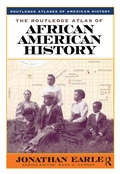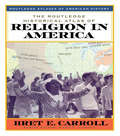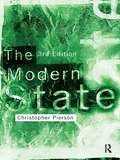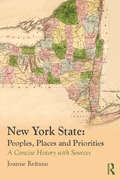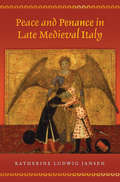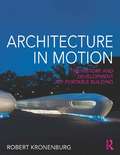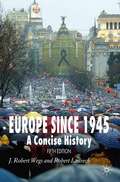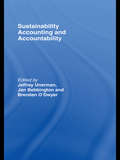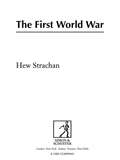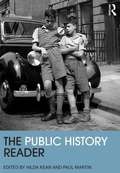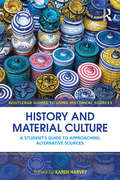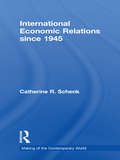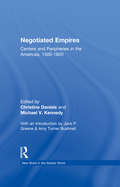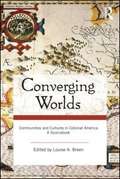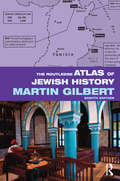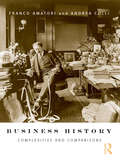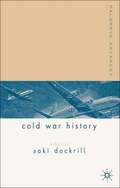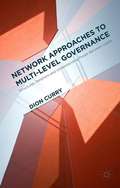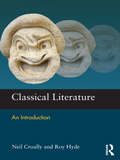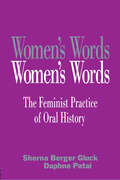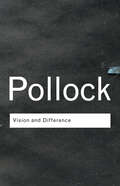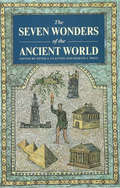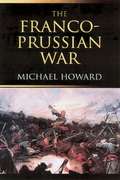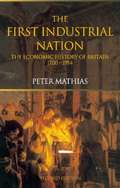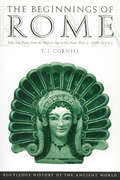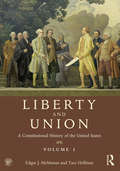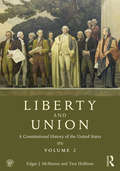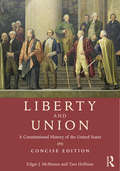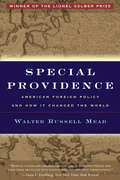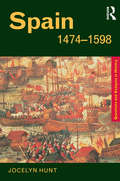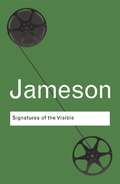- Table View
- List View
The Routledge Atlas of African American History
by Jonathan EarleFirst Published in 2000. Routledge is an imprint of Taylor & Francis, an informa company.
The Routledge Atlas of African American History
by Jonathan EarleFirst Published in 2000. Routledge is an imprint of Taylor & Francis, an informa company.
The Routledge Historical Atlas of Religion in America
by Brett CarrollFirst Published in 2001. Routledge is an imprint of Taylor & Francis, an informa company.
The Routledge Historical Atlas of Religion in America
by Brett CarrollFirst Published in 2001. Routledge is an imprint of Taylor & Francis, an informa company.
The Modern State
by Christopher PiersonThe new edition of this well-established and highly regarded textbook continues to provide the clearest and most comprehensive introduction to the modern state. It examines the state from its historical origins at the birth of modernity to its current jeopardized position in the globalized politics of the 21st Century. The book has been entirely revised and updated throughout, including substantial new material on the financial crisis and the environment. Subjects covered include: • The evolution of the state system • Placing the state in modernity• States and societies • State and economy • States and citizens • States and the international order • States of the twenty-first century This book is essential reading for all those studying the state, international relations and comparative politics.
The Modern State
by Christopher PiersonThe new edition of this well-established and highly regarded textbook continues to provide the clearest and most comprehensive introduction to the modern state. It examines the state from its historical origins at the birth of modernity to its current jeopardized position in the globalized politics of the 21st Century. The book has been entirely revised and updated throughout, including substantial new material on the financial crisis and the environment. Subjects covered include: • The evolution of the state system • Placing the state in modernity• States and societies • State and economy • States and citizens • States and the international order • States of the twenty-first century This book is essential reading for all those studying the state, international relations and comparative politics.
New York State: A Concise History with Sources
by Joanne ReitanoThe state of New York is virtually a nation unto itself. Long one of the most populous states and home of the country’s most dynamic city, New York is geographically strategic, economically prominent, socially diverse, culturally innovative, and politically influential. These characteristics have made New York distinctive in our nation’s history. In New York State: Peoples, Places, and Priorities, Joanne Reitano brings the history of this great state alive for readers. Clear and accessible, the book features: Primary documents and illustrations in each chapter, encouraging engagement with historical sources and issues Timelines for every chapter, along with lists of recommended reading and websites Themes of labor, liberty, lifestyles, land, and leadership running throughout the text Coverage from the colonial period up through the present day, including the Great Recession and Andrew Cuomo’s governorship Highly readable and up-to-date, New York State: Peoples, Places, and Priorities is a vital resource for anyone studying, teaching, or just interested in the history of the Empire State.
Peace and Penance in Late Medieval Italy
by Katherine Ludwig JansenMedieval Italian communes are known for their violence, feuds, and vendettas, yet beneath this tumult was a society preoccupied with peace. Peace and Penance in Late Medieval Italy is the first book to examine how civic peacemaking in the age of Dante was forged in the crucible of penitential religious practice.Focusing on Florence in the thirteenth and fourteenth centuries, an era known for violence and civil discord, Katherine Ludwig Jansen brilliantly illuminates how religious and political leaders used peace agreements for everything from bringing an end to neighborhood quarrels to restoring full citizenship to judicial exiles. She brings to light a treasure trove of unpublished evidence from notarial archives and supports it with sermons, hagiography, political treatises, and chronicle accounts. She paints a vivid picture of life in an Italian commune, a socially and politically unstable world that strove to achieve peace. Jansen also assembles a wealth of visual material from the period, illustrating for the first time how the kiss of peace—a ritual gesture borrowed from the Catholic Mass—was incorporated into the settlement of secular disputes.Breaking new ground in the study of peacemaking in the Middle Ages, Peace and Penance in Late Medieval Italy adds an entirely new dimension to our understanding of Italian culture in this turbulent age by showing how peace was conceived, memorialized, and occasionally achieved.
Peace and Penance in Late Medieval Italy
by Katherine Ludwig JansenMedieval Italian communes are known for their violence, feuds, and vendettas, yet beneath this tumult was a society preoccupied with peace. Peace and Penance in Late Medieval Italy is the first book to examine how civic peacemaking in the age of Dante was forged in the crucible of penitential religious practice.Focusing on Florence in the thirteenth and fourteenth centuries, an era known for violence and civil discord, Katherine Ludwig Jansen brilliantly illuminates how religious and political leaders used peace agreements for everything from bringing an end to neighborhood quarrels to restoring full citizenship to judicial exiles. She brings to light a treasure trove of unpublished evidence from notarial archives and supports it with sermons, hagiography, political treatises, and chronicle accounts. She paints a vivid picture of life in an Italian commune, a socially and politically unstable world that strove to achieve peace. Jansen also assembles a wealth of visual material from the period, illustrating for the first time how the kiss of peace—a ritual gesture borrowed from the Catholic Mass—was incorporated into the settlement of secular disputes.Breaking new ground in the study of peacemaking in the Middle Ages, Peace and Penance in Late Medieval Italy adds an entirely new dimension to our understanding of Italian culture in this turbulent age by showing how peace was conceived, memorialized, and occasionally achieved.
Architecture in Motion: The history and development of portable building
by Robert KronenburgThe idea that architecture can be portable is one that grabs the imagination of both designers and the people who use it, perhaps because it so often forecasts a dynamic and creative solution to the complex problems of our contemporary mobile society, while at the same time dealing with issues of practicality, economy and sustainability. Architecture in Motion examines the development of portable, transportable, demountable and temporary architecture from prehistory to the present day. From familiar vernacular models such as the tent, mobile home and houseboat, to ambitious developments in military and construction engineering, all aspects of portable building are considered. Building on his earlier works Portable Architecture and Houses in Motion, Robert Kronenburg compares traditional forms of building, current commercial products and the work of innovative designers, and examines key contemporary portable buildings to reveal surprising, exciting and imaginative examples. He explores the philosophical and technological issues raised by these experimental and futuristic prototypes. By understanding the nature of transitory architecture, a new ecologically aware design strategy can be developed to prioritise buildings that 'tread lightly on the earth' and still convey the sense of identity and community necessary for an established responsible society. This book provides a unique insight into this pivotal field of design.
Architecture in Motion: The history and development of portable building
by Robert KronenburgThe idea that architecture can be portable is one that grabs the imagination of both designers and the people who use it, perhaps because it so often forecasts a dynamic and creative solution to the complex problems of our contemporary mobile society, while at the same time dealing with issues of practicality, economy and sustainability. Architecture in Motion examines the development of portable, transportable, demountable and temporary architecture from prehistory to the present day. From familiar vernacular models such as the tent, mobile home and houseboat, to ambitious developments in military and construction engineering, all aspects of portable building are considered. Building on his earlier works Portable Architecture and Houses in Motion, Robert Kronenburg compares traditional forms of building, current commercial products and the work of innovative designers, and examines key contemporary portable buildings to reveal surprising, exciting and imaginative examples. He explores the philosophical and technological issues raised by these experimental and futuristic prototypes. By understanding the nature of transitory architecture, a new ecologically aware design strategy can be developed to prioritise buildings that 'tread lightly on the earth' and still convey the sense of identity and community necessary for an established responsible society. This book provides a unique insight into this pivotal field of design.
Europe Since 1945: A Concise History
by J. Robert Wegs Robert LadrechAs Europe has expanded its influence in world economic and political affairs, there has been an increased need to understand how Europe recovered from the devastation of World War II to become a major world player. This concise history offers a comprehensive overview of Europe's political, social, economic and cultural developments since 1945. J. Robert Wegs and Robert Ladrech balance a narrative of the major events and personalities of the post-war political scene with a critical assessment of key issues and themes, such as: - the development of the welfare state - European integration and the European Union - the Cold War - the rise and fall of the Soviet Empire - the political-economic turmoil in eastern Europe since 1989 - the place of Europe in the globalisation of the world's political-economic affairs. The text also features further reading sections at the end of each chapter to aid more detailed study, and is enhanced throughout with tables, maps and illustrations. Written for students and general readers alike, this thoroughly revised, updated and expanded new edition is an ideal introduction for anyone with an interest in the history and politics of post-war Europe, east and west.
Sustainability Accounting and Accountability
by Jan Bebbington Jeffrey Unerman Brendan O'DwyerThis exciting book is one of the first textbooks in the fast growing area of sustainability accounting. Contributed to, and edited by an impressive array of internationally renowned authorities, it focuses on the use of sustainability accounting both as an external accountability mechanism (external reporting) and as a tool for helping managers assess and manage the social and environmental impacts of their operations (management accounting). Using real-life examples and case studies to emphasize the links between the conceptual basis and issues in practice, this outstanding book addresses the growing interest among both practitioners and academics in social, environmental and ethical accountability, as interpreted through the lens of sustainable development.
The First World War: A New History
by Hew StrachanA brilliant and penetrating new history of the First World War by one of the world's foremost experts on the conflict. Reissued with a new introduction from the author. Hew Strachan is one of the world's foremost experts on the Great War of 1914-18. His on-going three-volume history of the conflict, the first of which was published in 2001, is likely to become the standard academic reference work: Max Hastings called it 'one of the most impressive books of modern history in a generation', while Richard Holmes hailed it as a 'towering achievement'. Now, Hew Strachan brings his immense knowledge to a one-volume work aimed squarely at the general reader. The inspiration behind the major Channel 4 series of the same name, to which Hew was chief consultant, THE FIRST WORLD WAR is a significant addition to the literature on this subject, taking as it does a uniquely global view of what is often misconceived as a prolonged skirmish on the Western Front. Exploring such theatres as the Balkans, Africa and the Ottoman Empire, Strachan assesses Britain's participation in the light of what became a struggle for the defence of liberalism, and show how the war shaped the 'short' twentieth century that followed it. Accessible, compelling and utterly convincing, this is modern history writing at its finest.
The Public History Reader (PDF)
by Hilda Kean Paul MartinDrawing on theory and practice from five continents, The Public History Reader offers clearly written accessible introductions to debates in public history as it places people, such as practitioners, bloggers, archivists, local historians, curators or those working in education, at the heart of history-making. Hilda Kean and Paul Martin explore public history as an everyday practice rather than simply as an academic discipline - the idea that historical knowledge is discovered and accrued from everyday encounters people have with their environments and the continuing dialogue that the present has with the past. Divided into three parts, Part I looks at who makes history, focusing on the ways in which the past has taken on a heightened popular sense of importance in the present and the ways in which it is used. Accordingly, history, far from being #65533;fixed#65533; in time, is fluid and is re-made to serve contemporary agendas in the present. Part II addresses the question of materials and approaches to making history. By using material more commonly within the domain of artists, collectors or geographers and archaeologists, public historians have opened up understandings of the past. Part III looks at the way in which presentations of the past change over time and their different forms and emphases. Throughout, the Reader emphasizes the challenges for public historians today. Using their own expertise in constructing and teaching a Public History MA, Hilda Kean and Paul Martin have suggested themes and indicative extracts that draw on their understanding of what works best with students. The Public History Reader is a perfect resource for all students of public history and all those interested in understanding the role of the past in our lives today.
History and Material Culture
by Karen HarveySources are the raw material of history, but where the written word has traditionally been seen as the principal source, today historians are increasingly recognizing the value of sources beyond text. In History and Material Culture, Karen Harvey embarks upon a discussion about material culture #65533; considering objects, often those found surrounding us in day to day life, as sources, which can help historians develop new interpretations and new knowledge about the past. Across ten chapters, different historians look at a variety of material sources from around the globe and across centuries to assess how such sources can be used to study history. While the sources are discussed from #65533;interdisciplinary#65533; perspectives, each contributor examines how material culture can be approached from an historical viewpoint, and each chapter addresses its theme or approach in a way accessible to readers without expertise in the area. In her introduction, Karen Harvey discusses some of the key issues raised when historians use material culture, and suggests some basic steps for those new to these kinds of sources. Opening up the discipline of history to new approaches, and introducing those working in other disciplines to historical approaches, this book is the ideal introduction to the opportunities and challenges of researching material culture.
History and Material Culture (PDF)
by Karen HarveySources are the raw material of history, but where the written word has traditionally been seen as the principal source, today historians are increasingly recognizing the value of sources beyond text. In History and Material Culture, Karen Harvey embarks upon a discussion about material culture #65533; considering objects, often those found surrounding us in day to day life, as sources, which can help historians develop new interpretations and new knowledge about the past. Across ten chapters, different historians look at a variety of material sources from around the globe and across centuries to assess how such sources can be used to study history. While the sources are discussed from #65533;interdisciplinary#65533; perspectives, each contributor examines how material culture can be approached from an historical viewpoint, and each chapter addresses its theme or approach in a way accessible to readers without expertise in the area. In her introduction, Karen Harvey discusses some of the key issues raised when historians use material culture, and suggests some basic steps for those new to these kinds of sources. Opening up the discipline of history to new approaches, and introducing those working in other disciplines to historical approaches, this book is the ideal introduction to the opportunities and challenges of researching material culture.
International Economic Relations since 1945
by Catherine R. SchenkThe international economy since 1945 has endured dramatic changes in its balance of power, from the early period of prosperity for industrialised nations, to the 2008/9 global crisis. In this volume Catherine Schenk outlines these huge changes, examines how the world’s economic leaders have tried to organise and influence the international economy and presents the key frameworks in which international economic relations have developed. Focusing on the pattern of international trade, international investment and the changing organisation of the international monetary system, this volume takes a chronological approach of key time-frames, and shows how policy has impacted the balance of the international economy. Major events such as European integration in the 1960’s, the collapse of the international monetary system and oil crisis in the 1970’s the return of China to the international economy in the 1980’s and emerging market crises in the 1990s are discussed within the context of key themes including global economic and regulatory co-ordination, the role of American economic hegemony, the evolution of exchange rate policy and unequal development. International Economic Relations since 1945 is the perfect guide for all students of economic history and international history, and for those seeking to understand recent economic trends in a longer term perspective.
Negotiated Empires: Centers and Peripheries in the Americas, 1500-1820 (PDF)
by Christine Daniels Leslie Page Moch Jack P. Greene Michael V. Kennedy Amy Turner BushnellThis volume brings together original essays by leading historians of the Atlantic World, representing recent developments in historiography of the period. These essays present the argument that coercive imperial authority has been vastly overrated. Distance, the primacy of trade over politics, and the refusal of colonized peoples to recognize European authority resulted in de-centralized American empires.
Negotiated Empires: Centers and Peripheries in the Americas, 1500-1820
by Christine Daniels Leslie Page Moch Jack P. Greene Michael V. Kennedy Amy Turner BushnellThis volume brings together original essays by leading historians of the Atlantic World, representing recent developments in historiography of the period. These essays present the argument that coercive imperial authority has been vastly overrated. Distance, the primacy of trade over politics, and the refusal of colonized peoples to recognize European authority resulted in de-centralized American empires.
Converging Worlds: A Sourcebook (PDF)
by Louise A. BreenProviding a survey of colonial American history both regionally broad and "Atlantic" in coverage, Converging Worlds presents the most recent research in an accessible manner for undergraduate students. The ideal accompaniment to Converging Worlds: Communities and Cultures in Colonial America, this Sourcebook is a collection of primary documents that contextualize and bring to life the exciting narrative of early America. The expert authors of each chapter have hand-picked multiple documents corresponding with the same chapter in the textbook to help students delve deeper into the diverse geographic regions and variety of topics covered in this time period, including: Letters Pamphlets and newspaper articles Excerpts from diaries Patents and charters Court records And much more! While the Sourcebook and text make a perfectly integrated package, the Sourcebook also features general introductions and section introductions framing the documents, so students can easily use it on its own to explore the vast colonial world up close. In addition to the helpful maps, timelines, and further resources available for students on the companion site, instructors will have access to the full text of many of the documents included in the Sourcebook. For additional information and classroom resources please visit the Converging Worlds companion website at www. routledge. com/cw/breen.
Converging Worlds: A Sourcebook
by Louise A. BreenProviding a survey of colonial American history both regionally broad and "Atlantic" in coverage, Converging Worlds presents the most recent research in an accessible manner for undergraduate students. The ideal accompaniment to Converging Worlds: Communities and Cultures in Colonial America, this Sourcebook is a collection of primary documents that contextualize and bring to life the exciting narrative of early America. The expert authors of each chapter have hand-picked multiple documents corresponding with the same chapter in the textbook to help students delve deeper into the diverse geographic regions and variety of topics covered in this time period, including: Letters Pamphlets and newspaper articles Excerpts from diaries Patents and charters Court records And much more! While the Sourcebook and text make a perfectly integrated package, the Sourcebook also features general introductions and section introductions framing the documents, so students can easily use it on its own to explore the vast colonial world up close. In addition to the helpful maps, timelines, and further resources available for students on the companion site, instructors will have access to the full text of many of the documents included in the Sourcebook. For additional information and classroom resources please visit the Converging Worlds companion website at www. routledge. com/cw/breen.
International Economic Relations since 1945
by Catherine R. SchenkThe international economy since 1945 has endured dramatic changes in its balance of power, from the early period of prosperity for industrialised nations, to the 2008/9 global crisis. In this volume Catherine Schenk outlines these huge changes, examines how the world’s economic leaders have tried to organise and influence the international economy and presents the key frameworks in which international economic relations have developed. Focusing on the pattern of international trade, international investment and the changing organisation of the international monetary system, this volume takes a chronological approach of key time-frames, and shows how policy has impacted the balance of the international economy. Major events such as European integration in the 1960’s, the collapse of the international monetary system and oil crisis in the 1970’s the return of China to the international economy in the 1980’s and emerging market crises in the 1990s are discussed within the context of key themes including global economic and regulatory co-ordination, the role of American economic hegemony, the evolution of exchange rate policy and unequal development. International Economic Relations since 1945 is the perfect guide for all students of economic history and international history, and for those seeking to understand recent economic trends in a longer term perspective.
The Routledge Atlas of Jewish History (PDF)
by Martin Gilbert'An unusual and compelling insight into Jewish history. . . sheer detail and breadth of scale' BBC History Magazine This newly revised and updated edition of Martin Gilbert's Atlas of Jewish History spans over four thousand years of history in 154 maps, presenting a vivid picture of a fascinating people and the trials and tribulations which have haunted their story. The themes covered include: Prejudice and Violence- from the destruction of Jewish independence between 722 and 586 BC to the flight from German persecution in the 1930s. Also covers the incidence of anti-semitic attacks in the Americas and Europe. Migrations and Movements- from the entry into the promised land to Jewish migration in the twenty- first century, including new maps on recent emigration to Israel from Europe and worldwide. Society, Trade and Culture- from Jewish trade routes between 800 and 900 to the situation of world Jewry in the opening years of the twenty- first century. Politics, Government and War- from the Court Jews of the fifteenth century to the founding and growth of the modern State of Israel. This new edition is also updated to include maps showing Jewish museums in the United States and Canada, and Europe, as well as American conservation efforts abroad. Other topics covered in this revised edition include Jewish educational outreach projects in various parts of the world, and Jews living under Muslim rule. Forty years on from its first publication, this book is still an indispensible guide to Jewish history.
The Routledge Atlas of Jewish History
by Martin Gilbert'An unusual and compelling insight into Jewish history. . . sheer detail and breadth of scale' BBC History Magazine This newly revised and updated edition of Martin Gilbert's Atlas of Jewish History spans over four thousand years of history in 154 maps, presenting a vivid picture of a fascinating people and the trials and tribulations which have haunted their story. The themes covered include: Prejudice and Violence- from the destruction of Jewish independence between 722 and 586 BC to the flight from German persecution in the 1930s. Also covers the incidence of anti-semitic attacks in the Americas and Europe. Migrations and Movements- from the entry into the promised land to Jewish migration in the twenty- first century, including new maps on recent emigration to Israel from Europe and worldwide. Society, Trade and Culture- from Jewish trade routes between 800 and 900 to the situation of world Jewry in the opening years of the twenty- first century. Politics, Government and War- from the Court Jews of the fifteenth century to the founding and growth of the modern State of Israel. This new edition is also updated to include maps showing Jewish museums in the United States and Canada, and Europe, as well as American conservation efforts abroad. Other topics covered in this revised edition include Jewish educational outreach projects in various parts of the world, and Jews living under Muslim rule. Forty years on from its first publication, this book is still an indispensible guide to Jewish history.
Business History: Complexities and Comparisons
by Franco Amatori Andrea ColliThis major new textbook on business history brings together the expertise of two internationally renowned authors to provide a thorough overview of the developments in business – from just before the industrial revolution right up to the present day. Business History is global in scope and looks at the major players – Europe, the US and Japan – as well as emerging economies, such as China and India. Focusing mainly on ‘big business‘, Amatori and Colli critically analyze ‘the firm‘ and its interaction with the evolution of economic, technological and political systems at the micro and macro levels. This up-to-date textbook is an exceptional resource for students on economic and business history courses, as well as for practitioners interested in broadening their understanding of business.
Business History: Complexities and Comparisons
by Franco Amatori Andrea ColliThis major new textbook on business history brings together the expertise of two internationally renowned authors to provide a thorough overview of the developments in business – from just before the industrial revolution right up to the present day. Business History is global in scope and looks at the major players – Europe, the US and Japan – as well as emerging economies, such as China and India. Focusing mainly on ‘big business‘, Amatori and Colli critically analyze ‘the firm‘ and its interaction with the evolution of economic, technological and political systems at the micro and macro levels. This up-to-date textbook is an exceptional resource for students on economic and business history courses, as well as for practitioners interested in broadening their understanding of business.
Palgrave Advances In Cold War History
by Geraint Hughes Saki DockrillThis innovative collection deals with the ideational, cultural, political and strategic aspects of the multifaceted Cold War. Drawing on the work of numerous established scholars and experts, this volume combines knowledge of the subject with key intellectual trends that have been developed over recent years.
Network Approaches to Multi-level Governance: Structures, Relations and Understanding Power between Levels (PDF)
by Dion CurryThis book explores how political structures and relations affect the 'black box of power' between governmental levels. It draws on case studies in Canada, the UK and continental Europe to illustrate how the design of political structures and the relative hierarchy of the relations between actors affect how governments deliver services.
Classical Literature: An Introduction
by Neil Croally Roy HydeClassical Literature: An Introduction provides a series of essays on all the major authors of Greek and Latin literature, as well as on a number of writers less often read. An introductory chapter provides information on important general topics, such as poetic metres, patronage and symposia. The literature is put in historical context, and the material is organized chronologically, but also by genre or author, as appropriate; each section or chapter has suggestions for further reading. The book ranges from Homer to the writers of the later Roman Empire, and includes a glossary, a chronology of literary and political events, and useful maps showing the origins of ancient writers. The collection will be essential for students and others who want a structured and informative introduction to the literature of the classical world.
Women's Words: The Feminist Practice of Oral History
by Daphne Patai Sherna Berger GluckWomen's Words is the first collection of writings devoted exclusively to exploring the theoretical, methodological, and practical problems that arise when women utilize oral history as a tool of feminist scholarship. In thirteen multi-disciplin ary esays, the book takes stock of the implicit presuppositions , contradictions, and prospects of oral history at the hands of feminist scholars.
Vision and Difference: Feminism, Femininity and Histories of Art
by Griselda PollockGriselda Pollock provides concrete historical analyses of key moments in the formation of modern culture to reveal the sexual politics at the heart of modernist art. Crucially, she not only explores a feminist re-reading of the works of canonical male Impressionist and Pre-Raphaelite artists including Edgar Degas and Dante Gabriel Rossetti, but also re-inserts into art history their female contemporaries - women artists such as Berthe Morisot and Mary Cassatt. Pollock discusses the work of women artists such as Mary Kelly and Yve Lomax, highlighting the problems of working in a culture where the feminine is still defined as the object of the male gaze. Now published with a new introduction, Vision and Difference is as powerful as ever for all those seeking not only to understand the history of the feminine in art, but also to develop new strategies for representation for the future.
The Seven Wonders of the Ancient World
by Martin Price Peter A ClaytonSets each of the seven wonders in their historical context, bringing together materials from ancient sources and the results of modern excavations to suggest why particular places and objects have been seen as the touchstone for human achievement.
The Franco-Prussian War: The German Invasion of France 1870–1871
by Michael HowardIn 1870 Bismarck ordered the Prussian Army to invade France, inciting one of the most dramatic conflicts in European history. It transformed not only the states-system of the Continent but the whole climate of European moral and political thought. The overwhelming triumph of German military might, evoking general admiration and imitation, introduced an era of power politics, which was to reach its disastrous climax in 1914. First published in 1961 and now with a new introduction, The Franco-Prussian War is acknowledged as the definitive history of one of the most dramatic and decisive conflicts in the history of Europe.
The Franco-Prussian War: The German Invasion of France 1870–1871
by Michael HowardIn 1870 Bismarck ordered the Prussian Army to invade France, inciting one of the most dramatic conflicts in European history. It transformed not only the states-system of the Continent but the whole climate of European moral and political thought. The overwhelming triumph of German military might, evoking general admiration and imitation, introduced an era of power politics, which was to reach its disastrous climax in 1914. First published in 1961 and now with a new introduction, The Franco-Prussian War is acknowledged as the definitive history of one of the most dramatic and decisive conflicts in the history of Europe.
The First Industrial Nation: The Economic History of Britain 1700–1914
by Peter MathiasThis celebrated and seminal text examines the industrial revolution, from its genesis in pre-industrial Britain, through its development and into maturity. A chapter-by-chapter analysis explores topics such as economic growth, agriculture, trade finance, labour and transport. First published in 1969, The First Industrial Nation is widely recognised as a classic text for students of the industrial revolution.
The First Industrial Nation: The Economic History of Britain 1700–1914
by Peter MathiasThis celebrated and seminal text examines the industrial revolution, from its genesis in pre-industrial Britain, through its development and into maturity. A chapter-by-chapter analysis explores topics such as economic growth, agriculture, trade finance, labour and transport. First published in 1969, The First Industrial Nation is widely recognised as a classic text for students of the industrial revolution.
The Beginnings of Rome: Italy and Rome from the Bronze Age to the Punic Wars (c.1000–264 BC)
by Tim CornellUsing the results of archaeological techniques, and examining methodological debates, Tim Cornell provides a lucid and authoritative account of the rise of Rome. The Beginnings of Rome offers insight on major issues such as: Rome’s relations with the Etruscans the conflict between patricians and plebeians the causes of Roman imperialism the growth of slave-based economy. Answering the need for raising acute questions and providing an analysis of the many different kinds of archaeological evidence with literary sources, this is the most comprehensive study of the subject available, and is essential reading for students of Roman history.
The Beginnings of Rome: Italy and Rome from the Bronze Age to the Punic Wars (c.1000–264 BC)
by Tim CornellUsing the results of archaeological techniques, and examining methodological debates, Tim Cornell provides a lucid and authoritative account of the rise of Rome. The Beginnings of Rome offers insight on major issues such as: Rome’s relations with the Etruscans the conflict between patricians and plebeians the causes of Roman imperialism the growth of slave-based economy. Answering the need for raising acute questions and providing an analysis of the many different kinds of archaeological evidence with literary sources, this is the most comprehensive study of the subject available, and is essential reading for students of Roman history.
Liberty and Union: A Constitutional History of the United States, volume 1
by Edgar J. McManus Tara HelfmanThis, the first of two volumes of Liberty and Union, is a comprehensive constitutional history of the United States from the Anglo-American origins of the Constitution through the colonial and antebellum periods, to the Civil War and the consequent restructuring of the nation. Written in a clear and engaging narrative style, it successfully unites thorough chronological coverage with a thematic approach, offering critical analysis of core constitutional history topics, set in the political, social, and economic context that made them constitutional issues in the first place. Combining a thoughtful and balanced narrative with an authoritative stance on key issues, the authors explain the past in the light of the past, without imposing upon it the standards of later generations. Authored by two experienced professors of History and Law this textbook has been thoughtfully constructed to offer an accessible alternative to dense scholarly works – avoiding unnecessary technical jargon, defining legal terms and historical personalities where appropriate, and making explicit connections between constitutional themes and historical events. For students in an undergraduate or postgraduate constitutional history course, or anyone with a general interest in constitutional developments, this book will be essential reading. Useful features include: Full glossary of legal terminology Recommended reading A table of cases Extensive supporting artwork Companion website Useful documents provided: Declaration of Independence Articles of Confederation Constitution of the United States of America Chronological list of Supreme Court justices
Liberty and Union: A Constitutional History of the United States, volume 1
by Edgar J. McManus Tara HelfmanThis, the first of two volumes of Liberty and Union, is a comprehensive constitutional history of the United States from the Anglo-American origins of the Constitution through the colonial and antebellum periods, to the Civil War and the consequent restructuring of the nation. Written in a clear and engaging narrative style, it successfully unites thorough chronological coverage with a thematic approach, offering critical analysis of core constitutional history topics, set in the political, social, and economic context that made them constitutional issues in the first place. Combining a thoughtful and balanced narrative with an authoritative stance on key issues, the authors explain the past in the light of the past, without imposing upon it the standards of later generations. Authored by two experienced professors of History and Law this textbook has been thoughtfully constructed to offer an accessible alternative to dense scholarly works – avoiding unnecessary technical jargon, defining legal terms and historical personalities where appropriate, and making explicit connections between constitutional themes and historical events. For students in an undergraduate or postgraduate constitutional history course, or anyone with a general interest in constitutional developments, this book will be essential reading. Useful features include: Full glossary of legal terminology Recommended reading A table of cases Extensive supporting artwork Companion website Useful documents provided: Declaration of Independence Articles of Confederation Constitution of the United States of America Chronological list of Supreme Court justices
Liberty and Union: A Constitutional History of the United States, volume 2
by Edgar J. McManus Tara HelfmanThis, the second of two volumes of Liberty and Union, is a comprehensive constitutional history of the United States from the Progressive Era of the early twentieth century to the most recent decisions of the Supreme Court on contemporary constitutional issues. Written in a clear and engaging narrative style, it successfully unites thorough chronological coverage with a thematic approach, offering critical analysis of core constitutional history topics, set in the political, social, and economic context that made them constitutional issues in the first place. Combining a thoughtful and balanced narrative with an authoritative stance on key issues, the authors deliberately explain the past in the light of the past, without imposing upon it the standards of later generations. Authored by two experienced professors in the field, this textbook has been thoughtfully constructed to offer an accessible alternative to dense scholarly works – avoiding unnecessary technical jargon, defining legal terms and historical personalities where appropriate, and making explicit connections between constitutional themes and historical events. For students in an undergraduate or postgraduate constitutional history course, or anyone with a general interest in constitutional developments, this book will be essential reading. Useful features include: Full glossary of legal terminology Recommended reading A table of cases Extracts from primary documents Companion website Useful documents provided: Declaration of Independence Articles of Confederation Constitution of the United States of America Chronological list of Supreme Court justices
Liberty and Union: A Constitutional History of the United States, volume 2
by Edgar J. McManus Tara HelfmanThis, the second of two volumes of Liberty and Union, is a comprehensive constitutional history of the United States from the Progressive Era of the early twentieth century to the most recent decisions of the Supreme Court on contemporary constitutional issues. Written in a clear and engaging narrative style, it successfully unites thorough chronological coverage with a thematic approach, offering critical analysis of core constitutional history topics, set in the political, social, and economic context that made them constitutional issues in the first place. Combining a thoughtful and balanced narrative with an authoritative stance on key issues, the authors deliberately explain the past in the light of the past, without imposing upon it the standards of later generations. Authored by two experienced professors in the field, this textbook has been thoughtfully constructed to offer an accessible alternative to dense scholarly works – avoiding unnecessary technical jargon, defining legal terms and historical personalities where appropriate, and making explicit connections between constitutional themes and historical events. For students in an undergraduate or postgraduate constitutional history course, or anyone with a general interest in constitutional developments, this book will be essential reading. Useful features include: Full glossary of legal terminology Recommended reading A table of cases Extracts from primary documents Companion website Useful documents provided: Declaration of Independence Articles of Confederation Constitution of the United States of America Chronological list of Supreme Court justices
Liberty and Union: A Constitutional History of the United States, concise edition
by Edgar J. McManus Tara HelfmanThis, the concise edition of Liberty and Union, is an abridged constitutional history of the United States, designed for short single-semester courses, comprising the key topics from Volumes 1 and 2. Written in a clear and engaging narrative style, it successfully unites thorough chronological coverage with a thematic approach, offering critical analysis of core constitutional history topics, set in the political, social, and economic context that made them constitutional issues in the first place. Combining a thoughtful and balanced narrative with an authoritative stance on key issues, the authors deliberately explain the past in the light of the past, without imposing upon it the standards of later generations. Authored by two experienced professors in the field, this concise edition presents seminal topics while retaining the narrative flow of the two full original volumes. An accessible alternative to dense scholarly works, this textbook avoids unnecessary technical jargon, defines legal terms and historical personalities where appropriate, and makes explicit connections between constitutional themes and historical events. For students in a short undergraduate or postgraduate constitutional history course, or anyone with a general interest in constitutional developments, this book will be essential reading. Useful features include: Full glossary of legal terminology Recommended reading A table of cases Extracts from primary documents Companion website Useful documents provided: Declaration of Independence Articles of Confederation Constitution of the United States of America Chronological list of Supreme Court justices
Liberty and Union: A Constitutional History of the United States, concise edition
by Edgar J. McManus Tara HelfmanThis, the concise edition of Liberty and Union, is an abridged constitutional history of the United States, designed for short single-semester courses, comprising the key topics from Volumes 1 and 2. Written in a clear and engaging narrative style, it successfully unites thorough chronological coverage with a thematic approach, offering critical analysis of core constitutional history topics, set in the political, social, and economic context that made them constitutional issues in the first place. Combining a thoughtful and balanced narrative with an authoritative stance on key issues, the authors deliberately explain the past in the light of the past, without imposing upon it the standards of later generations. Authored by two experienced professors in the field, this concise edition presents seminal topics while retaining the narrative flow of the two full original volumes. An accessible alternative to dense scholarly works, this textbook avoids unnecessary technical jargon, defines legal terms and historical personalities where appropriate, and makes explicit connections between constitutional themes and historical events. For students in a short undergraduate or postgraduate constitutional history course, or anyone with a general interest in constitutional developments, this book will be essential reading. Useful features include: Full glossary of legal terminology Recommended reading A table of cases Extracts from primary documents Companion website Useful documents provided: Declaration of Independence Articles of Confederation Constitution of the United States of America Chronological list of Supreme Court justices
Special Providence: American Foreign Policy and How It Changed the World
by Walter Russell Mead"God has a special providence for fools, drunks and the United States of America."--Otto von BismarckAmerica's response to the September 11 attacks spotlighted many of the country's longstanding goals on the world stage: to protect liberty at home, to secure America's economic interests, to spread democracy in totalitarian regimes and to vanquish the enemy utterly.One of America's leading foreign policy thinkers, Walter Russell Mead, argues that these diverse, conflicting impulses have in fact been the key to the U.S.'s success in the world. In a sweeping new synthesis, Mead uncovers four distinct historical patterns in foreign policy, each exemplified by a towering figure from our past.Wilsonians are moral missionaries, making the world safe for democracy by creating international watchdogs like the U.N. Hamiltonians likewise support international engagement, but their goal is to open foreign markets and expand the economy. Populist Jacksonians support a strong military, one that should be used rarely, but then with overwhelming force to bring the enemy to its knees. Jeffersonians, concerned primarily with liberty at home, are suspicious of both big military and large-scale international projects.A striking new vision of America's place in the world, Special Providence transcends stale debates about realists vs. idealists and hawks vs. doves to provide a revolutionary, nuanced, historically-grounded view of American foreign policy.
Special Providence: American Foreign Policy and How It Changed the World
by Walter Russell Mead"God has a special providence for fools, drunks and the United States of America."--Otto von BismarckAmerica's response to the September 11 attacks spotlighted many of the country's longstanding goals on the world stage: to protect liberty at home, to secure America's economic interests, to spread democracy in totalitarian regimes and to vanquish the enemy utterly.One of America's leading foreign policy thinkers, Walter Russell Mead, argues that these diverse, conflicting impulses have in fact been the key to the U.S.'s success in the world. In a sweeping new synthesis, Mead uncovers four distinct historical patterns in foreign policy, each exemplified by a towering figure from our past.Wilsonians are moral missionaries, making the world safe for democracy by creating international watchdogs like the U.N. Hamiltonians likewise support international engagement, but their goal is to open foreign markets and expand the economy. Populist Jacksonians support a strong military, one that should be used rarely, but then with overwhelming force to bring the enemy to its knees. Jeffersonians, concerned primarily with liberty at home, are suspicious of both big military and large-scale international projects.A striking new vision of America's place in the world, Special Providence transcends stale debates about realists vs. idealists and hawks vs. doves to provide a revolutionary, nuanced, historically-grounded view of American foreign policy.
Spain 1474–1598
by Jocelyn HuntThe rise of Spain from obscurity to the position of one of Europe's greatest powers is centrally important in the history of Western Europe in the sixteenth century. Spain 1474–1598 explores key themes including the unification of Spain and the domestic and foreign policies of each of the monarchs, Ferdinand and Isabella, Charles V and Philip II. This book also examines whether the sixteenth century was a 'golden century' for Spain culturally with its art and literature, as well as its society and economy.
Spain 1474–1598
by Jocelyn HuntThe rise of Spain from obscurity to the position of one of Europe's greatest powers is centrally important in the history of Western Europe in the sixteenth century. Spain 1474–1598 explores key themes including the unification of Spain and the domestic and foreign policies of each of the monarchs, Ferdinand and Isabella, Charles V and Philip II. This book also examines whether the sixteenth century was a 'golden century' for Spain culturally with its art and literature, as well as its society and economy.
Signatures of the Visible
by Frederic JamesonIn such celebrated works as Postmodernism: The Cultural Logic of Late Capitalism, Fredric Jameson has established himself as one of America’s most observant cultural commentators. In Signatures of the Visible, Jameson turns his attention to cinema - the artform that has replaced the novel as the defining cultural form of our time. Historicizing a form that has flourished in a post-modern and anti-historical culture, he explores the allegorical and ideological dimensions of such films as The Shining, Dog Day Afternoon and the works of Alfred Hitchcock, among many others. Fifteen years on from its original publication, this remains a piercing and original analysis of film from a writer and thinker whose influence continues to be felt long after that of the fashionable post-modernists he has always critiqued.
